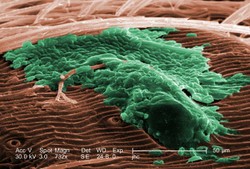Biofilms are aggregates of one or several types of microorganisms, and they may occur on any surface. These commonly include plastics, metals, medical implant devices, and environments underground. They especially form when there are moisture and nutrients on the surface. They can coat rocks in streams or rivers, and they tend to excrete a slimy and glue-like material [1, 2].
In humans they will lead to chronic infection. Well-known examples of this are dental plaque and the presence of periodontitis, lung infections in patients with cystic fibrosis, and chronic wounds which have been present for several months. The biofilms adhere as a matrix, and this enables the microorganisms to tolerate a hostile environment which free-floating or planktonic bacteria cannot [1, 2].




 The Reality of Aspirinon 05/24/2021
The Reality of Aspirinon 05/24/2021
 An Old Microbeon 03/31/2021
An Old Microbeon 03/31/2021
 Coronavirus and Mental Illnesson 02/14/2021
Coronavirus and Mental Illnesson 02/14/2021
 Acute Ischemic Strokeon 12/25/2020
Acute Ischemic Strokeon 12/25/2020


Comments
My daughter is doing her PhD on biofilms and their ability to be manipulated for the purposes of purifying sewage waters and producing electricity as a side-effect.